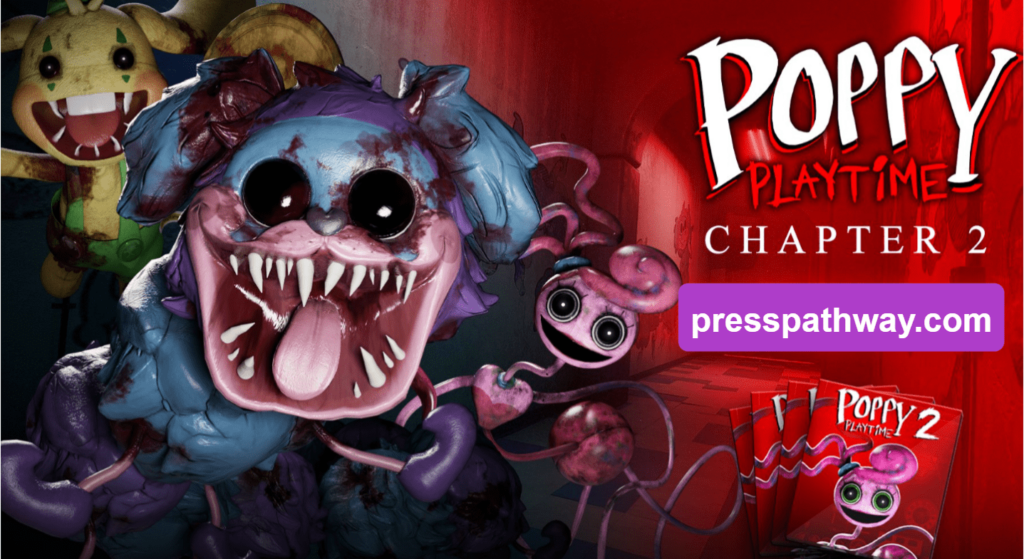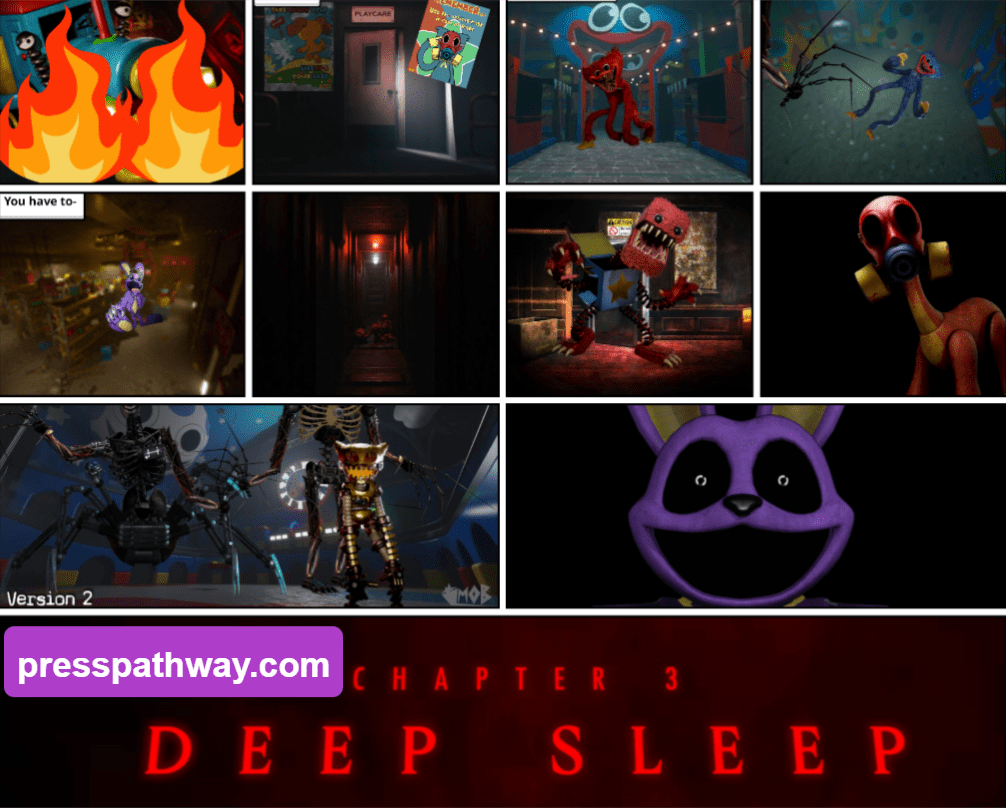While Poppy Playtime may lure players with its innocent appearance—vibrant colors, a whimsical factory, and charming characters—it conceals a sinister side that has captivated over 5 million players.
Before allowing your kids to join the trend, it’s crucial to recognize the darker layers beneath the game’s seemingly child-friendly exterior. Our revealing expose delves into the unsettling truths lurking within Poppy’s Playtime, exposing the unsettling reality hidden behind the facade. Explore the unexpected and potentially disturbing elements that may lie within this seemingly harmless game.
Unraveling the Mystery: What Exactly Is Poppy Playtime?
Poppy Playtime is a popular horror video game developed by Mob Entertainment, known for its unique chapter-based release structure. With a substantial player base on Steam and an estimated 5 million players, the game has gained traction for its suspenseful gameplay. Chapters 1 and 2 are available on various platforms, and anticipation is high for the upcoming third chapter expected in winter 2023. Despite its seemingly child-friendly appearance, Poppy Playtime incorporates horror elements, making it important for parents to monitor their children’s gameplay to ensure a safe and enjoyable experience.
Poppy Playtime chapter 1 : Introducing Huggy Wuggy

In the initial chapter of Poppy Playtime, players encounter the seemingly innocent yet perilous character, Huggy Wuggy. Despite its harmless appearance as a blue stuffed animal, Huggy Wuggy possesses a dangerous nature, featuring razor-sharp teeth capable of causing severe harm, including tearing heads off.
To progress through the chapter and ultimately overcome Huggy Wuggy, players engage in solving intricate puzzles and utilizing specialized tools. The Grabpack, a key object in the game, proves essential for completing electrical circuits, unlocking new locations, and manipulating objects within the environment.
As players successfully solve puzzles, the dormant factory gradually comes to life. Activating old machinery and equipment allows players to navigate previously inaccessible areas, ultimately leading to the confrontation with Huggy Wuggy. The climax involves defeating the character, causing it to drop from a significant height.
The game’s narrative unveils a backstory where the player, having worked at Playtime Co., a toy and doll manufacturing factory, returns years later. The factory’s dark history includes toys gaining sentience and causing harm, prompting its closure. Players embark on a journey to unravel the mysteries behind the factory and understand the sinister motives behind the sentient toys.
Poppy Playtime chapter 2: Defeat Mommy Long Legs and Soar Through the Web

In Chapter 2, you’ll unravel the twist that Huggy Wuggy’s demise was a cunning deception. Instead, a new character, Mommy Long Arms, steps into the spotlight, rescuing Huggy just as it seemed all was lost. Mommy Long Arms lives up to her name, showcasing an impressive ability to elongate her limbs and head, much like the Grabpack adorning you.
Unlike the silent Huggy, Mommy Long Arms engages in frequent communication, challenging you to conquer three games with the promise of aiding your escape upon victory. However, as fate would have it, the course of events deviates from the expected outcome, and you find yourself compelled to thwart Mommy Long Arms by ensnaring her in the clutches of an industrial grinder.
When will Poppy Playtime Chapter 3 Release?

Chapter 3: “Deep Sleep” marks the next thrilling chapter in the indie series Poppy Playtime, slated for an early 2024 release. Stepping into the spotlight as the primary antagonist is Daydreamer, with the other Smiling Companions playing crucial roles as secondary antagonists. Get ready for a journey deeper into the mysteries of the Poppy Playtime universe as you navigate through surreal landscapes and confront the enigmatic challenges that lie ahead.
Is Poppy Playtime Kid-Friendly? Assessing Potential Risks
Given its horror genre roots, Poppy Playtime incorporates several elements that may impact kids differently based on their individual temperament. Some 10 to 11-year-olds, possessing a resilient and brave nature, may navigate through the game’s chilling scenes without significant distress. On the flip side, it could genuinely unsettle others, emphasizing the importance of understanding your child’s unique characteristics before permitting them to engage with this game.
For those seeking insights into the level of scariness in Poppy Playtime, the following highlights potential risks that exposing your child to the game might entail, including:
1. Exploring Jumpscares in Poppy Playtime
Jump scares are a prevalent element in horror narratives, and Poppy Playtime makes extensive use of them. The mechanics behind a jump scare are simple: a serene and quiet scene is abruptly disrupted by a sudden image change, often accompanied by a loud and frightening sound.
Huggy Wuggy and Mommy Long Legs frequently make unexpected appearances, relentlessly pursuing the player throughout the entire factory. One parental reviewer on Common Sense Media expressed frustration, noting that the jump scares posed a challenge for both them and their 14-year-old, who struggled to complete the game.
However, in our testing, the overall experience leaned more towards amusement than fear. This underscores the significance of the player’s psychological disposition in shaping the impact of the game.
2. Stress Levels
For a child with limited exposure to horror movies or games, diving into Poppy Playtime can heighten their stress levels. A constant sense of being pursued, particularly when alone or in dimly lit settings, may persist. Moreover, this heightened anxiety could extend to influence their perceptions of commonplace items such as dolls, toys, and other playthings.
In the interest of fostering healthy development, it’s advisable for children and adolescents to steer clear of experiences that induce abnormal levels of anxiety. Given their ongoing growth and potentially limited emotional maturity, processing such distressing scenes might pose challenges to their well-being.
3. Sleep Disturbances
When anxiety becomes overwhelming, whether in children or adults, it can disrupt normal sleep patterns. The apprehension of falling asleep, coupled with the fear of nightmares, may lead to sleep-related issues. Common Sense Media explicitly identifies Poppy Playtime as a potential catalyst for nightmares.
Persistent disruptions to sleep may eventually result in insomnia, characterized by either total or partial sleep loss. For the targeted demographic of students aged 6 to 13, the Sleep Foundation recommends a crucial 9 to 11 hours of sleep. Adhering to this recommended sleep duration is essential for maintaining sharp cognitive functions, ensuring the child remains alert throughout the day. When children struggle with sleep, their mental and physical development may face significant risks.
4. Blood & Violence
The game involves thematic elements of gore and violence, although explicit scenes are strategically avoided. The narrative includes hostile dolls, blood splatters, and intense moments, such as trapping an antagonist in an industrial grinder in Chapter 2. Parents are advised to consider their child’s temperament before allowing them to engage with the game to ensure a positive and age-appropriate experience.
5. Game Dependency
Poppy Playtime, while offering an engaging gaming experience, raises concerns beyond the realm of fear for children. The potential for addiction to the game is highlighted, driven by its entertaining puzzles and mechanics. Children might find themselves spending excessive amounts of time playing, risking issues related to prolonged gaming.
The average completion time for a chapter is estimated to be one to two hours, influenced by individual skills and experience. However, the allure of the game may lead to repeated replays and the pursuit of hidden features. Unchecked gaming addiction carries various consequences, including obesity, sleep disorders, and potential engagement in piracy, as some players may resort to torrent sites.
6. Risk-Taking Behavior
The expansive world of Poppy Playtime game unfolds within a factory setting that mirrors a colossal playhouse. To progress through the game and overcome hostile toys, players engage with a variety of mechanical devices.
The game features activities such as interacting with electrical devices, maneuvering through confined holes and vents, and descending stairs with regularity. These scenes may inadvertently encourage young children to replicate these actions in real life, potentially placing themselves in serious danger. The game’s immersive environment could blur the lines between fiction and reality, necessitating caution to prevent real-world consequences from self-endangering behavior.
Poppy Playtime’s Reach: Exploring the Ways Information Spreads
In the era of digital communication, the swift dissemination of information across the globe has become a norm. Here are some primary avenues through which individuals share details about Poppy Playtime.
1. YouTube
Being the premier video platform on the internet, YouTube plays a pivotal role in amplifying the Poppy Playtime phenomenon through influential content creators and the developers themselves. Renowned YouTubers such as Markiplier draw in massive audiences, with over 20 million viewers experiencing the thrills of Poppy Playtime through their streams.
Furthermore, Mob Games, the creators of Poppy Playtime, leverage their official YouTube channel to directly promote the game to millions of subscribers. Trailers and videos shared on this platform contribute significantly to the game’s exposure. Given the ubiquitous access kids have to YouTube, managing their awareness of Poppy Playtime’s escalating online presence poses a considerable challenge. Navigating the potential emergence of unsettling content associated with this viral gaming sensation remains an ongoing concern for vigilant parents in the digital age.
2. Friends and Schools
In 2021, following the release of the first chapter, Poppy Playtime captured the attention of children and young adolescents, sparking widespread interest. The inaugural chapter of the game garnered massive popularity, with some kids finding Huggy Wuggy endearing, despite its sharp teeth.
The character’s fame has transcended the digital realm, evolving into a global phenomenon manifested in the form of stuffed toys. Kids across the world carry these plush dolls in various hues, such as blue, pink, and more. The character’s widespread appeal can be attributed to its inherent fun factor, and it also serves as a tool for children to process their fears, particularly related to stuffed animals and dolls.
Even if parents attempt to shield their children from the game, the likelihood of them hearing about it from friends at school or on social media is high. Word-of-mouth and peer influence play significant roles, as kids catch wind of the game from their peers and subsequently express their interest, exemplifying the contagious nature of trends.
3. Roblox
Roblox stands as a prominent online gaming platform, offering users the ability to design and create games even without prior programming knowledge. Unsurprisingly, the platform has become a breeding ground for numerous Poppy Playtime adaptations. If your kids are active on Roblox, there’s a considerable chance they might encounter one of these variations and subsequently develop curiosity about the original game.
While many of these games maintain the original name, Poppy Playtime, some opt for creative alternatives like “Loppy Playtime” or “Survival The Huggy Wuggy.” Although most strive to replicate the game’s mechanics, certain elements may be absent. For instance, emulating the Grabpack’s throwing arms proves challenging, leading players to navigate by touching desired objects instead. Despite these limitations, the world-building in these adaptations is often impressive, featuring virtually every room and chamber found in the original game.
Understanding Poppy Playtime’s Age Suitability
Determining the age appropriateness of Poppy Playtime proves challenging due to the absence of a universally agreed-upon age rating. Various organizations, including Common Sense Media, provide different ratings based on parental reviews. Common Sense Media rates it 15+, with individual parent ratings ranging from 8+ to adults 18 and older. Other sources, including certain children-focused organizations and entertainment websites like Spiel Times, suggest 8+ and 12+ ratings as the most common.
Notably, there’s a lack of information on Mob Entertainment’s rating, but the App Store and Play Store classify it as suitable for teens. In the end, the responsibility lies with parents to understand their child’s maturity level before deciding whether Poppy Playtime is suitable for them.
Why Poppy Playtime Isn’t Recommended for Children
After firsthand experience and thorough research, it is clear that Poppy Playtime is not appropriate for younger audiences, despite its toy-themed characters and setting. The horror elements in the game can be highly startling for children. The game’s widespread popularity on social media, including kid-focused platforms like YouTube Kids, has exposed it to a younger audience. While the CEO of Mob Entertainment suggests it’s suitable for children aged eight and up, the majority of parents argue for an age restriction of 15 and above.
The conflicting opinions are reflected in platform ratings, with the Google Play Store and the App Store giving it a 12+ rating. In conclusion, Poppy Playtime appears more suitable for a teenage audience, drawing parallels with its horror gaming counterpart, Five Nights at Freddy’s.
Poppy Playtime Duration: How Long Will the Thrills Last?
Poppy Playtime is an ongoing episodic game with two released chapters and a third on the horizon. Each chapter varies in length, with Chapter 1 at approximately 35 minutes, Chapter 2 doubling that duration, and Chapter 3 expected to triple it. The game’s overall duration is influenced by the player’s skill level, as adept players can solve puzzles and defeat antagonists more quickly, offering a dynamic and personalized gaming experience.
Conclusion
Poppy Playtime, akin to horror franchises like Child’s Play and Five Nights at Freddy’s, is not suitable for children due to its horror elements, potentially featuring scary or violent scenes. Acknowledging the ongoing development of children’s mental acuity, parents are encouraged to regulate their exposure to such content. Utilizing parental control apps provides a practical solution for restricting access to age-inappropriate games. Informed by this understanding, parents can make thoughtful decisions regarding their children’s engagement with Poppy Playtime, ensuring a responsible and age-appropriate gaming experience.
FAQs
Is Poppy Playtime available for free?
The availability and pricing of Poppy Playtime vary depending on your device. Windows users can obtain Chapter 1 for free through Steam, while iOS and Android users are required to pay $2.99 for access. For Chapter 2, the cost differs across platforms, with Android pricing at $4.99, iOS at $5.99, and Steam at $9.99.
What devices support the gameplay of Poppy Playtime?
Poppy Playtime is accessible on various devices, including Windows, iOS, and Android platforms, offering a versatile gaming experience for users on these supported devices.
What is the rating of Poppy Playtime on gaming platforms?
Poppy Playtime lacks an official rating, and assessments from different organizations vary. Some suggest it’s suitable for children aged eight and above, while others recommend it for teenagers aged 12 and older.


